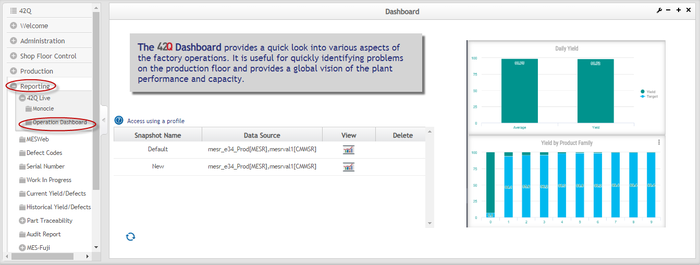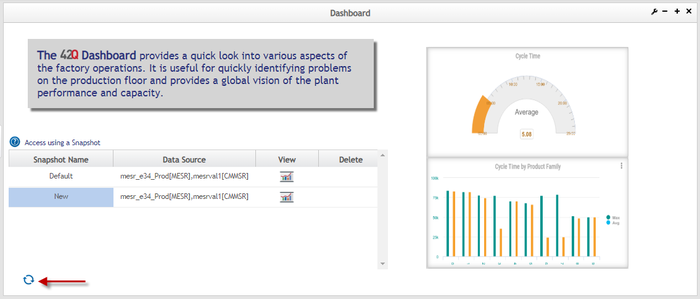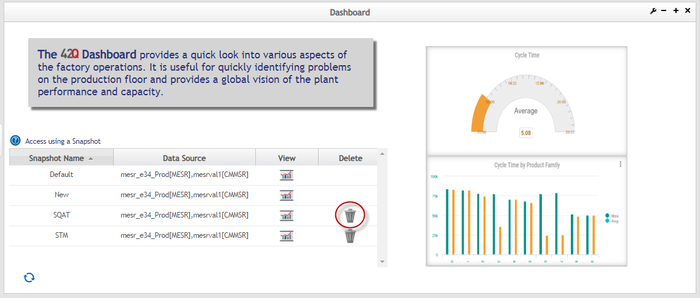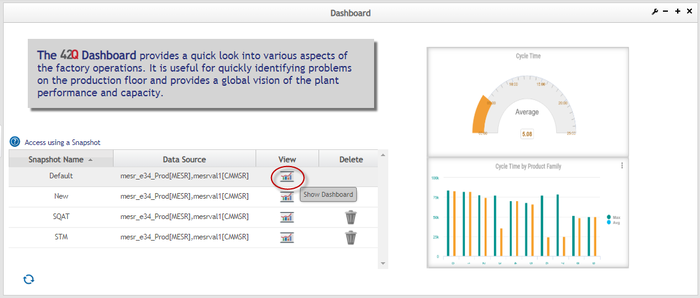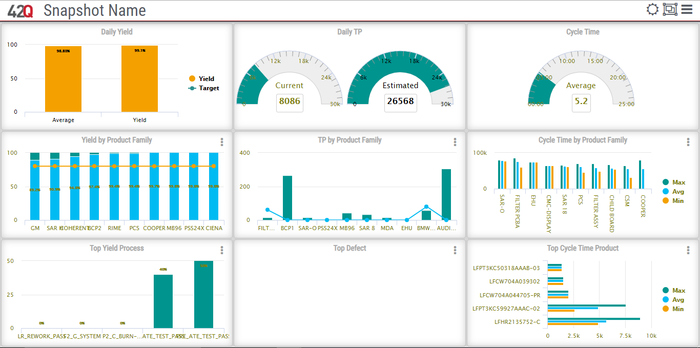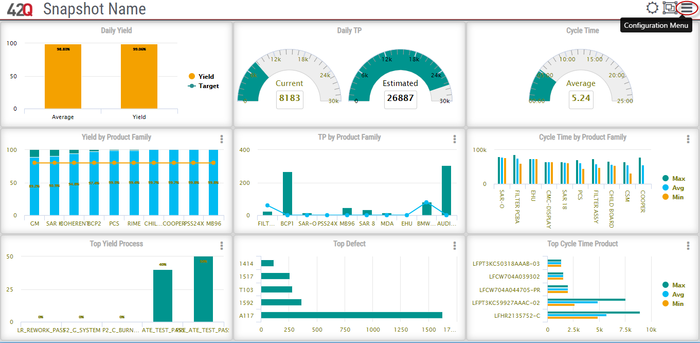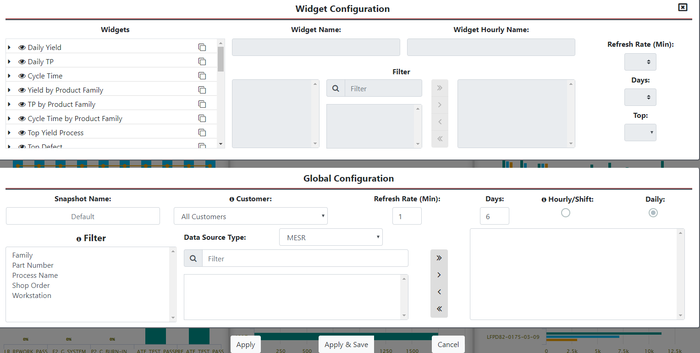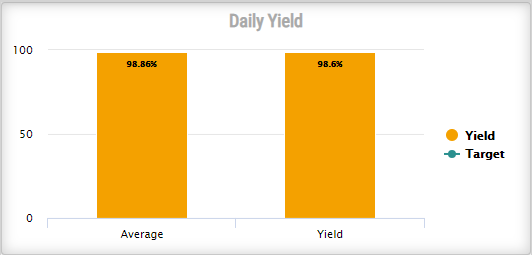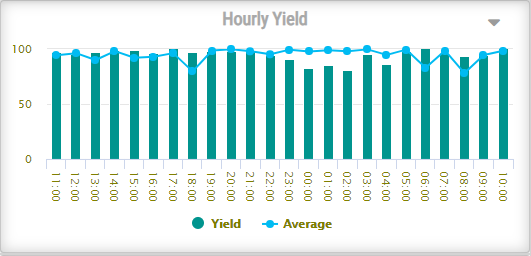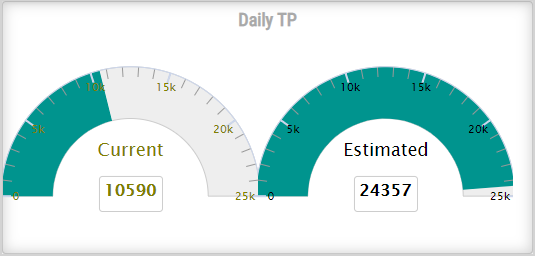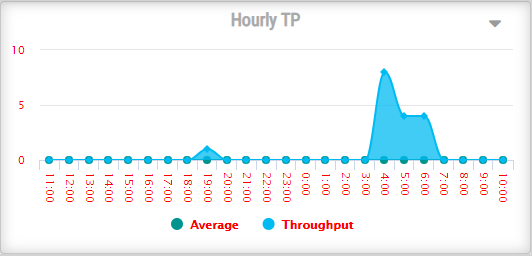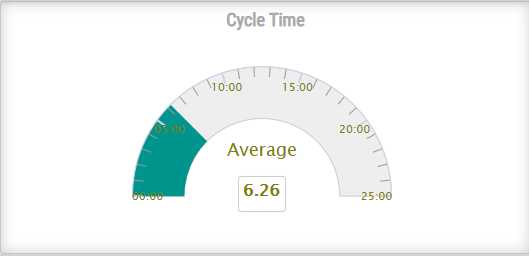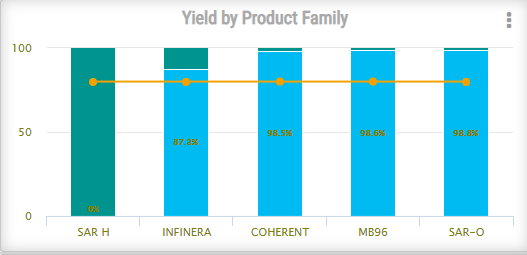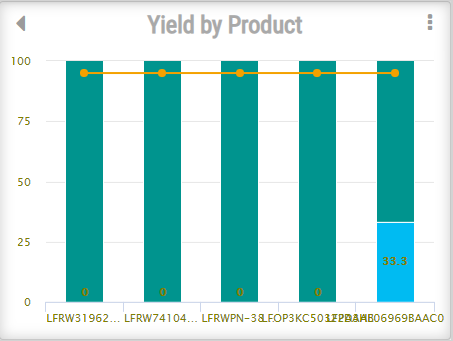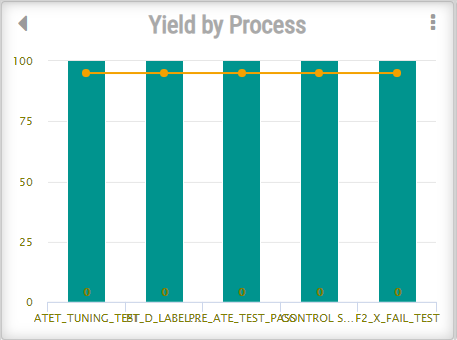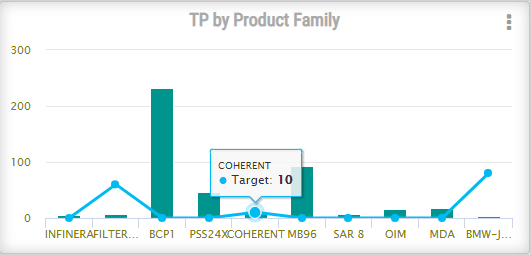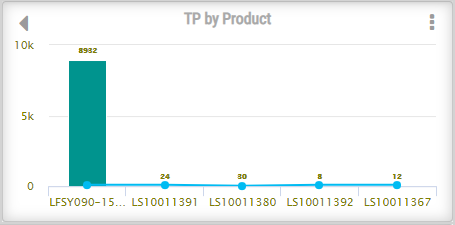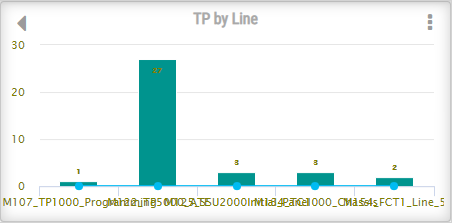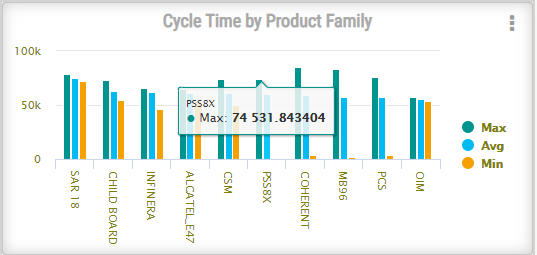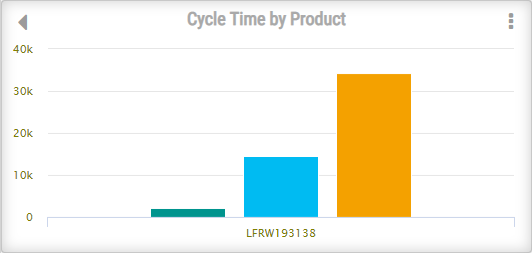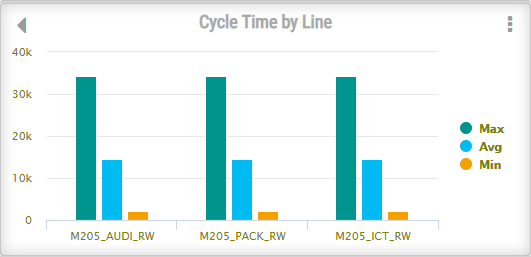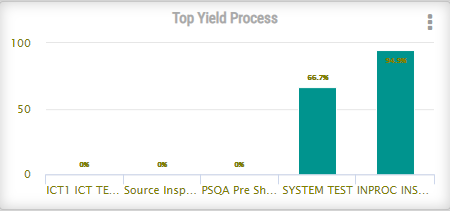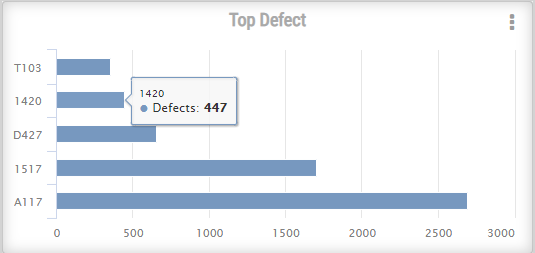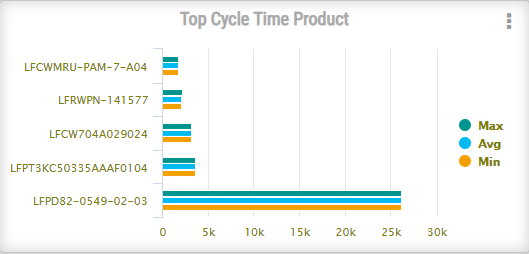Difference between revisions of "SOP-42Q-MES0107 Operation Dashboard"
| Line 74: | Line 74: | ||
| | ||
| + | |||
| Line 79: | Line 80: | ||
= Displaying the Dashboard = | = Displaying the Dashboard = | ||
| − | # Choose Default to create a dashboard with MES 101 reports. | + | #Choose Default to create a dashboard with MES 101 reports. |
| − | + | <ol start="2"> | |
| − | + | <li>Choose New to create a custom dashboard (OEE reports and selected MES 101 reports).</li> | |
| + | </ol> | ||
'''Figure 4 : Select a Data Source''' | '''Figure 4 : Select a Data Source''' | ||
Revision as of 19:42, 24 August 2018
42Q Home > Reporting > Operations Dashboard

This edition applies to the MES 15 4 Application and all subsequent releases and modifications until otherwise indicated in new revisions.
Contents
Description
The 42Q Operation Dashboard provides a quick look into various aspects of factory operations. It is useful for quickly identifying problems on the production floor and provides a global vision of a plant’s performance and capacity.
Operation Dashboard condenses productivity reports gathered from the MESWeb into 9 standard statistical charts that can be accessed remotely from Android tablets or viewed on large screens situated on the shop floor. Data is refreshed on the screen according to predefined parameters of 1 - 60-minute intervals. The reports are divided into 3 categories: Global, Product Family, and Top.
Operation Dashboard is accessible via MES Portal in the reporting module. (Reporting > 42Q Live > Operation Dashboard).
Figure 1: Operation Dashboard: Welcome Screen
Snapshots
Users can save reports as Snapshots, which include statistical charts, parameters, refresh rate, and customized parameters. Snapshots allow the user to manage multiple dashboards with different settings separately for ease of use. The Dashboard includes one standard snapshot (Default) and one customizable snapshot (New). With the New snapshot, users can create snapshots according to their needs.
- Default Snapshot: Default Snapshot directs users to the Dashboard Screen, where they may select data from all customers in the database. This option is pre-configured and ready for immediate use.
- New Snapshot: The New Snapshot directs users to a blank screen where they can select which statistical reports to display based on their individual reporting needs. All customers in the database are available for selection.
Refresh the Profile List
After making changes to a profile, select the Refresh button to update the profile list.
Figure 2: List of Profiles: Refresh Profiles
NOTE: Customized snapshots are managed and visible only at the user level. They cannot be shared with others.
Typically, users have access to only one Data Source that is selected automatically by the system, based on predefined permissions.
Delete a Snapshot
To delete a snapshot from the list:
- Select the Trash can icon under the Delete snapshot for the chosens.
- Select the Refresh button to reload the Profile list. The deleted profile will no longer be displayed.
Figure 3: Profile List: Delete a Profile
Displaying the Dashboard
- Choose Default to create a dashboard with MES 101 reports.
- Choose New to create a custom dashboard (OEE reports and selected MES 101 reports).
Figure 4 : Select a Data Source
NOTE: Data Sources are automatically displayed according to user's permissions.
- Choose View to display the Dashboard:
Figure 5: Default Operations Dashboard
Default snapshot will display the known 9 reports related to MES101.
Configuring the Dashboard
The Operations Dashboard allows the user to configure which widgets to display, the refresh interval, and the length of data to gather for the widget. By default, the Dashboard shows average results from the past 6 days. Users may configure the system to display results anywhere between 1 and 14 days. Target value average statistics can be configured in the same way.
Figure 6: Operations Dashboard: Settings Menu
To configure the Dashboard in the Settings menu:
Figure 7: Configuration Options
Global Configurations are applied to the entire dashboard, whereas Widget Configurations are applied to individual widgets.
Widget Configuration
Users can edit any of the widgets from the Snapshot window. Widgets not selected for the current layout are designated by a covered eye icon.
Figure 8: Widget Configuration
This section of the configuration menu allows applying filters to widgets individually. There is a list of all existing widgets that can be configured.
Note that a widget is a view that can contain one or multiple reports. Filters are applied to each report. There is an icon at the right of each widget that allows to “clone” a widget, so there could be as many as the user wants with different filters.
Select one report and then select the filter to be applied. One or multiple values can be selected.
Once the configuration is complete, select Apply, Apply & Save or Cancel.
- Apply will only make the changes visible temporarily.
- Apply & Save will make the changes visible but will also save them in the Snapshot.
- Cancel will cancel any change done and will close the configuration window.
The Refresh Rate defines how often data is refreshed from the database.
- Days option applies only to those widgets that have an option to display data for a number of days passed.
- Top option applies for Top reports, the user can select from top 5 or top10
Figure 9: Global Configuration
Enter a Snapshot Name.
Select a customer from the drop-down list.
Note that in the case of MES data, a specific customer can be selected, so Dashboard will display data for that customer only. This doesn’t apply for OEE data.
- Select either the Hourly/Shift (Hourly for MES / Shift for OEE) or Daily radio button to determine the frequency of the report.
- By hour: Displays the data from the past 60 minutes.
- By day: Displays data from 00:00 to the current time.
- Select the Refresh Rate andDays (6 to 14 days). These configurations are the same options described above for individual configuration, how often to refresh data from the database and how many days of data to display on those reports that it is applicable, but now applied to all widgets on the Dashboard.
- Hourly andDaily options can be selected to display data for the last hour or the last day (00:00 to current time) for MES data. For OEE it is a little different Hourly will display data for the last shift, while Daily will display data for the current day (00:00 to current time).
- Before selecting a filter on the global section, select a data source, as it is different for the different reports. Select MESR or CMMSR (for OEE widgets). MESR has Part Family, Part Number, Process Name, Shop Order and Workstation options and CMMRS has Asset, Line, Part Number and Part Family.
- Once the configuration is complete, select Apply, Apply & Save or Cancel. The Saved Snapshots will be listed on the portlet and will also be visible at the top of the Dashboard.
Layout Menu
The layout can be set as per user preference from this menu (https://lh5.googleusercontent.com/EPt_083S5Ibts8qMrSoayFpVi2YDxlQMdWhfuVVsfkzPgbwHsZNXLOcz_1LOwcljKrCF7IUgv_3l1n-m8fBK2SWG29KE1qISEK_leUfPVgOslqr_1Yf9cpZ-QLqnyj9vb-IFlEQX), in order to add more widgets there should be space available so other widgets would need to be removed or resized.
NOTE: Widgets can be expanded but not collapsed, in order to make one smaller, it would be necessary to remove it and add it again
Once the layout is defined, users can select to apply the changes or cancel them with these buttons https://lh3.googleusercontent.com/ZagogjI2CAab5sOzSB2220v6WbE7jnFKzBawW0oQYdox7Fvn-bnJy_9KpcwJXqIK4HRFCKMp0jmZNToaxDY5GyV4LmpvuGw1X_Gbf2Wpk-TdeXn2MiM-VTtBXCe9OXwrA24h1931
Note that apply doesn’t mean saved, this will apply only in the current view, I’ll describe how to save in the next menu.
Global Reports
Global reports provide plant level information regarding Yield, TP(Throughput), and Cycle Time. Reports shown are based on the Customer selected in the Settings window.
Daily Yield/Hourly Yield
Daily Yield/Hourly Yield reports compare current yield value against the average value of the last number(n) of days. Established target values are also displayed.
Daily Yield is getting the information from “Operation_Dashboard_yield_by_day” report. It is getting the yield from the selected customer from the current day at 00:00 to the current hour.
Figure 10: Daily Yield
Formulas used for Daily Yield
For the Daily Yield, the calculation is done based on the total processed units, passed units and failed units. The formula to calculate Yield is:
Yield = (Passed_Units / Total_Processed_Units) * 100
If we have
Total Units = 10
Passed Units = 8
Failed Units = 2
Applying the formula we got:
Yield = (8 / 10) * 100 = 0.8 * 100 = 80
Yield = 80%
For the “Yield“ calculation on this particular report, we based it on the total units passed on the current day. The “Average” calculation is based on the average of the past “n” days yield.
The number of days(“n” value used before) used in this report is selected by the user from 6 to 14 days.
Hour mode displays yield and average yield values by the hour. Users can select whether to see the last 12 or 24 hours.
Hourly Yield is getting the information from “Operation_Dashboard_yield_by_hours” report.
This report shows a chart with two sets of series, one is line series and the other is the bar series, they are showing the following information as follows:
e.g. Current hour: 4:11 am
Figure 11: Hourly Yield
Daily Throughput/ Hourly Throughput
The Daily Throughput report displays the current throughput in the first chart and provides an estimated value to reach by the end of the day on the second chart. The estimated values are based on the current TP/hours worked.
- By Day mode displays TP values from 00:00 to current time.
Figure 12: Daily Throughput
- By Hour mode displays the current TP value hour by hour for the current day, and the average TP during those same hours, but in the past number(n) of days. Users can select whether the report displays data from the last 12 or 24 hours.
Figure 13: Hourly Throughput
Cycle Time
Cycle Time represents the average time to build a single unit on the shop floor. Cycle Time is charted by day or by hour, depending on whether By Day or By Hour is chosen in the Dashboard settings menu.
Figure 14: Cycle Time
Product Family Reports
The Dashboard has 3 reports with data based on Product Families:Yield by Product Family, TP by Product Family, andCycle Time by Product Family. These reports can be filtered to display a graph for a particular Product Family, Product, and Process/Line.
Filtering Product Family Reports
In each level of a Product Family report, the user is able to select which information to display, and whether to sort it by the Top 10 or the Top 5.
To filter a report:
- Select the vertical three-dot menu in the top right corner of the report.
A list of Product Families, Products, or Processes displays depending on what is to be filtered.
Figure 15: Filtering Menu
- Select the radio button for either Top 10 or Top 5 to sort the list.
- Close the window to remove the window.
Yield by Product Family
The Yield for the Product Family report displays the % of yield for the filtered Product Family. The report can display further information by selecting a Product Family from the graph.
Figure 16: Yield by Product Family
- Select a Product Family from the report to load the Yield by Product report.
Yield By Product
The Yield by Product report displays information about the Top 10 or Top 5 (depending on the selection in the Filter pop-up window) products for the selected Part Family based on yield.
Figure 17: Yield by Product
From here, the user can select the back arrow to return to the Yield by Product Family report.
The user can also filter this report by Top 10 or Top 5 and choose which Products to display (Refer to Figure 15)
As with the previous report, the user can also see the Yield by Process for a Product, but selecting a Product from the graph.
Yield by Process
Figure 18: Yield by Process
The Yield by Process report displays a graph for the Product selected in the previous level of report.
As with the previous report, the user can filter which data to display and whether to display the Top 10 or Top 5.
To return to the previous report, select the arrow in the top left corner(Refer to Figure 15).
Throughput by Product Family
The Throughput by Product Family displays a report for either the Top 10 or Top 5 Product Families (Refer to Filtering Product Family Reports) based on their TP.
- To access the TP by Product Family settings window, select the menu icon on the top right corner of the report.
Figure 19: TP by Product Family
- Select a Product Family from the report to load the TP by Product report.
Throughput by Product
The TP by Product report displays the TP for the Products of the selected Product Family. As with the previous report, the user can set which products to display and sort them by either the Top 10 or the Top 5.
Figure 20: TP by Product
The user can either select the arrow in the top left corner to return to TP by Product Family report, or select a Product to load the TP by Line report.
Throughput By Line
The TP by Line report displays the TP for the Line of the selected Product. As with the previous report, the user can set which products to display and sort them by either the Top 10 or the Top 5 using the 3 dot menu.
Figure 21: TP by Line
To return to the previous report, select the arrow in the top left corner(Refer toFigure 15).
Cycle Time by Product Family
The Cycle Time by Product Family report displays the amount of time used to build a product, including the minimum and maximum values during the same period. As with previous Product Family reports, the user can select which Product Families to include in the report and sort them by either the Top 10 or the Top 5 based on their cycle times.
Figure 22: Cycle Time by Product Family
Access the Cycle Time by Product report by selecting a Product Family from the report.
Cycle Time by Product
The Cycle Time by Product report displays the Cycle Time for the Products of the selected Product Family. As with the previous report, the user can set which products to display and sort them by either the Top 10 or the Top 5 with the 3 dot menu.
Figure 23: Cycle Time by Product
Cycle Time by Line
The Cycle Time by Line report displays the Cycle Time for the Line of the selected Product. As with the previous report, the user can set which products to display and sort them by either the Top 10 or the Top 5.
Figure 24: Cycle Time by Line
To return to the previous report, select the arrow in the top left corner (Refer to Figure 17).
Top Reports
The Dashboard includes 3 Top reports: Top Yield Process, Top Defects, and Top Cycle Time Product.
Top Yield Process
This report displays the top five processes with the lowest yield % making it easier for users to identify processes with problems.
Figure 25: Top Yield Process
By selecting the menu at top right corner users can select which of the 5 processes to display or hide.
Top Defect
This chart represents the 5 most common defects in the last hour or day, depending the mode selected. Users may select which defects display by selecting the check mark in the display column of the pop-up menu.
Figure 26: Top Defect
Top Cycle Time Product
This report displays the top five products that took the longest time to build based on the average time to build the same product in the last hour or day. The Top Cycle Time Product report also displays the product’s minimum and maximum values. As with other Top reports, users may select which items to view by marking the appropriate checkmark in the Display column of the Report’s pop up menu.
Figure 27: Top Cycle Time Product
Document Revision History
| Date | Author | Title | Version | Change Reference |
| 08/08/17 | Lucas Hopkins | Technical Writer | A | This is the first version of Operation Dashboard for 42Q. |
